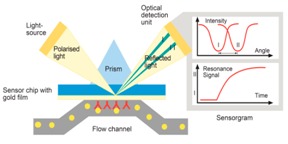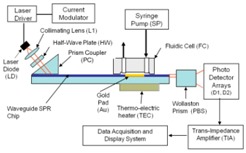Table 3.
Comparison of Biacore and NP SPR systems.
| Biacore SPR T100 | NP Wave Guide SPR | |
|---|---|---|
| Automated | Yes | Yes |
| Temperature Control (°C) | 4–40 | Room temperature |
| Flow Channels | 4 | 4 |
| Flow cell Volume | 60 nL | 1 µL |
| Refractive Index Range | 1.33–1.36 | Same |
| Detection principle | The molecular interaction (cleavage or binding) is detected by measuring the change in the resonance angle; SPR causes a reduction in the intensity of reflected light at a specific angle of reflection. This angle varies with the refractive index close to the surface on the side opposite from the reflected light (sample side). | The molecular interaction is detected by measuring the refractive index induced change in intensity of the TM-polarized component of a transmitted light beam. High sensitivity is achieved by using the index-insensitive TE-polarized component of the same light beam as a reference. Thus canceling out the instrument’s opto-mechanical noise |
| Software | LAB View TM (not material) | |
| Baseline noise (RU) | 1 resonance units (RU). (One RU = index change of 10−6 | 0.01 RU |
| Online subtraction of background response | Yes (Flow cells 2-1, 3-1,4-1) | Yes |
| Help to study | Affinity, Kinetics, Binding, Specificity, concentration | same |
| Instrumentation |  |
 |
| Sensor Chip Cost | $150 per chip for the dextran chips | <$2 (estimated) |
